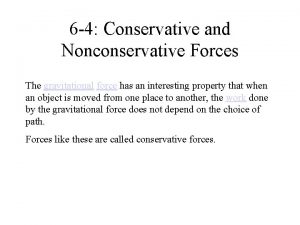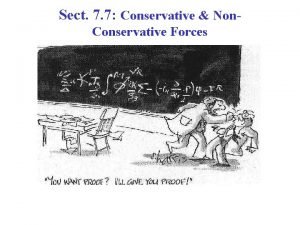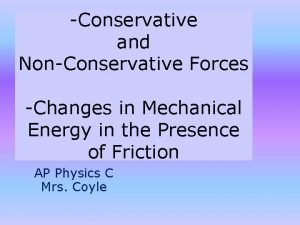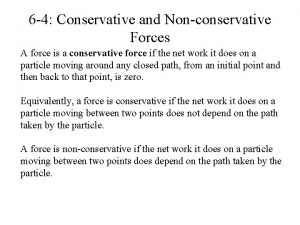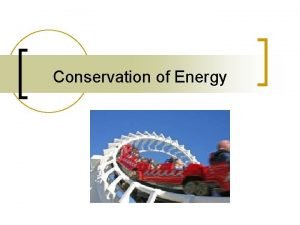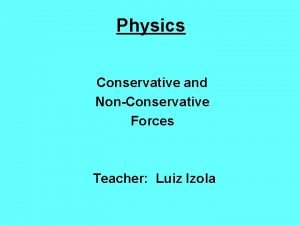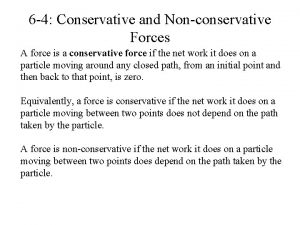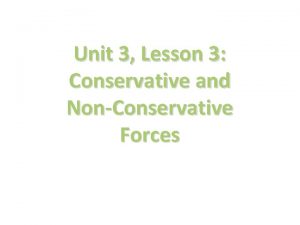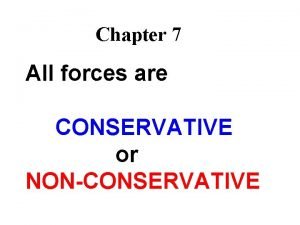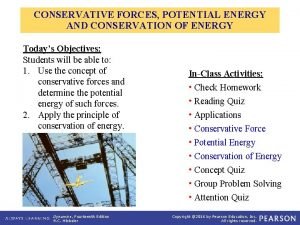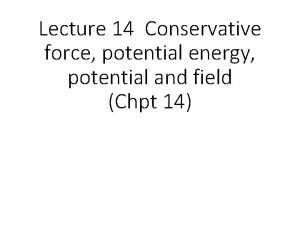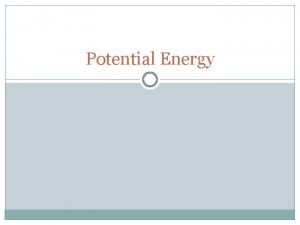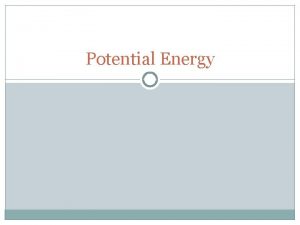Lecture 11 Potential energy Conservative and nonconservative forces
















- Slides: 16

Lecture 11: Potential energy • Conservative and non-conservative forces • Potential energy • Total mechanical energy • Energy conservation

Conservative forces A force is called conservative if the work it does on an object as the object goes between two points is independent of the path. ⟶ The work done by a conservative force along any two paths between the same two points is the same.

Example: Work done by gravity

Properties of conservative forces:

Constant forces are conservative Caution: 1. Force must be constant in magnitude and direction. 2. Not every conservative force has to be constant.

Non-conservative forces If the work done by a force depends on the path, the force is non-conservative. Different paths between initial and final point give different amount of work Work for closed path is not zero. HW: examine frictional force

Potential energy difference: definition

Potential energy: reference point

Potential energy of gravity* *near Earth’s surface (y-axis vertically up)


Potential energy of spring force From lecture 10:

Total mechanical energy


Example In a new Olympic discipline, a ski jumper of mass M is launched by means of a compressed spring of spring constant k. At the top of a frictionless ski jump at height H above the ground, he is pushed against the spring, compressing it a distance L. When he is released from rest, the spring pushes him so he leaves the lower end of the ski jump with a speed V at a positive angle θ with respect to the horizontal. Determine the height D of the end of the ski jump in terms of given system parameters.

Tension in coupled objects Net work done by tension in coupled system is zero

Example with coupled objects A block of mass m is on a frictionless incline that makes an angle θ with the vertical. A light string attaches it to another block of mass M that hangs over a massless frictionless pulley. The blocks are then released from rest, and the block of mass M descends. What is the blocks’ speed after they move a distance D?
 Is gravitational force conservative or non-conservative why
Is gravitational force conservative or non-conservative why Conservative forces examples
Conservative forces examples Physics 03-01 work and the work-energy theorem
Physics 03-01 work and the work-energy theorem Force conservative et non conservative
Force conservative et non conservative Force conservative et non conservative
Force conservative et non conservative Volts to ev
Volts to ev Pe q
Pe q Is electric force a conservative force
Is electric force a conservative force Why is spring force conservative
Why is spring force conservative Electrical potential energy
Electrical potential energy Kinetic energy examples
Kinetic energy examples Kinetic energy of a spring
Kinetic energy of a spring Kinetic energy and potential energy formula
Kinetic energy and potential energy formula Formula of potential energy
Formula of potential energy Potential energy of capacitor
Potential energy of capacitor Is mechanical energy potential or kinetic
Is mechanical energy potential or kinetic Definition of elastic potential energy
Definition of elastic potential energy
